Secure Cloud Database Implementation: Strategies and Considerations
VerifiedAdded on 2023/06/04
|5
|1108
|352
Essay
AI Summary
This essay discusses the implementation of web databases in the cloud, emphasizing the critical security considerations necessary to protect data. It outlines the step-by-step process of setting up a cloud account, authenticating credentials, and selecting appropriate database options like MSQL for scalability. The essay highlights the importance of creating strong, frequently updated passwords and employing end-to-end encryption to prevent unauthorized access. Additionally, it suggests resetting database ports to non-default values to mitigate automated attacks. The overall aim is to provide a comprehensive overview of how to securely implement a web database in the cloud, ensuring data accessibility for authorized users while minimizing vulnerabilities.
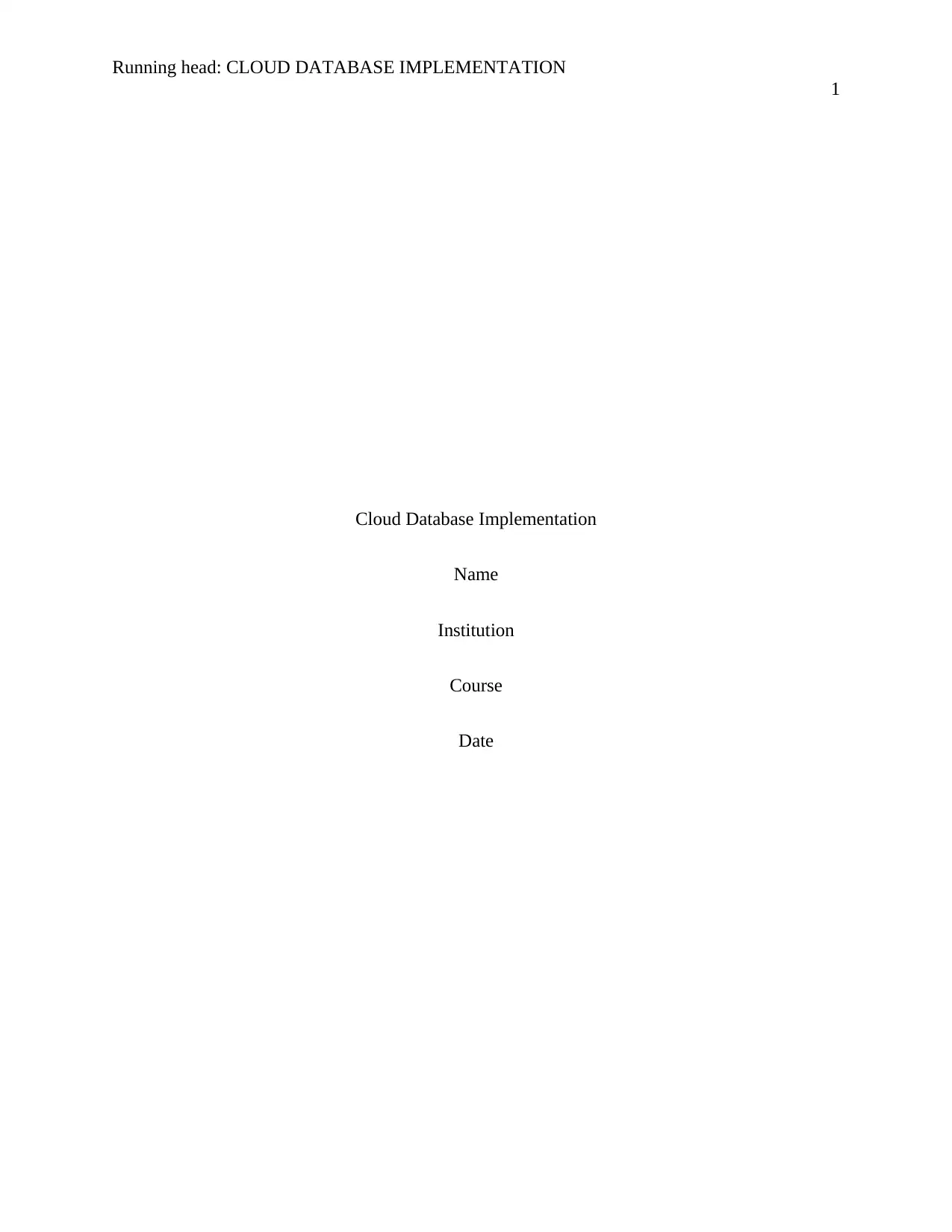
Running head: CLOUD DATABASE IMPLEMENTATION
1
Cloud Database Implementation
Name
Institution
Course
Date
1
Cloud Database Implementation
Name
Institution
Course
Date
Paraphrase This Document
Need a fresh take? Get an instant paraphrase of this document with our AI Paraphraser
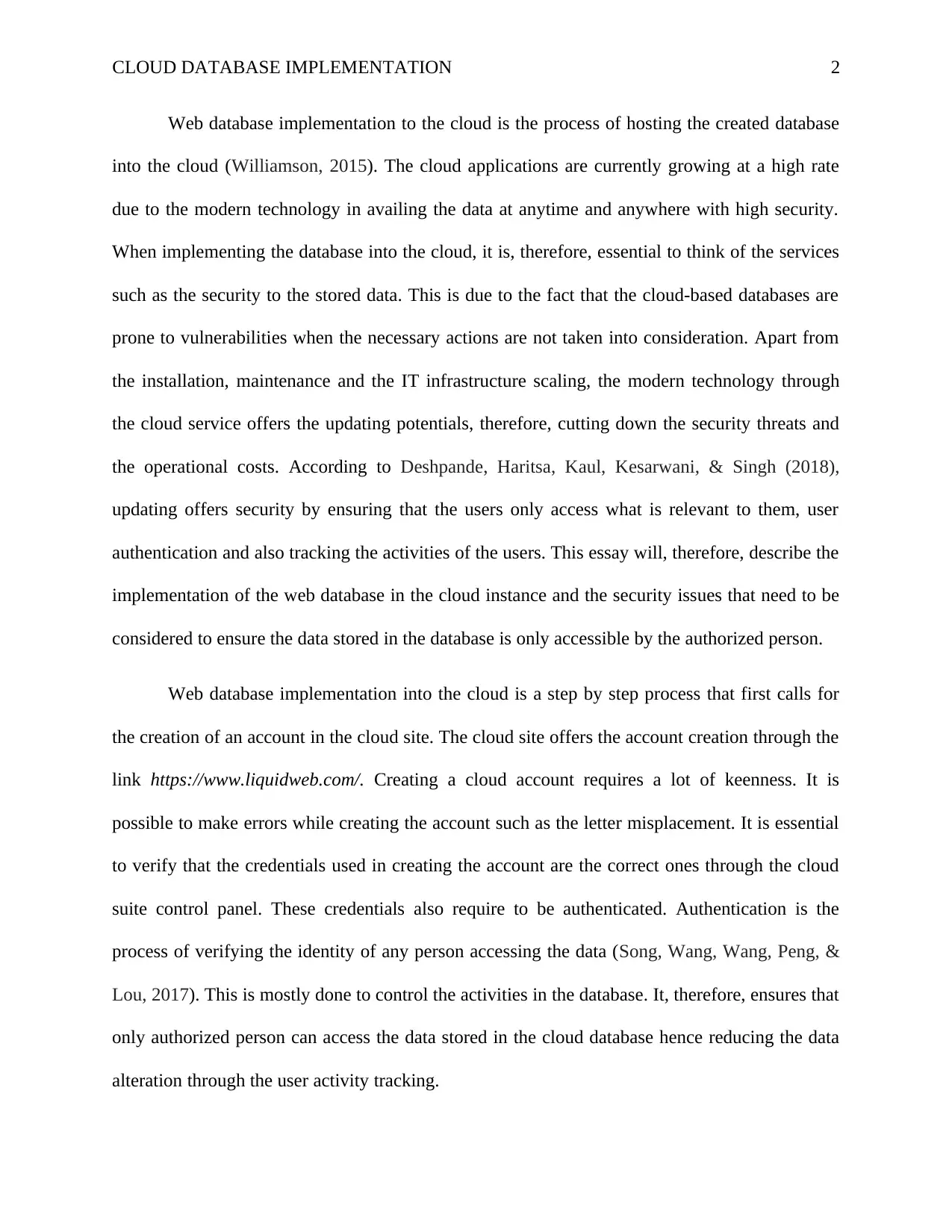
CLOUD DATABASE IMPLEMENTATION 2
Web database implementation to the cloud is the process of hosting the created database
into the cloud (Williamson, 2015). The cloud applications are currently growing at a high rate
due to the modern technology in availing the data at anytime and anywhere with high security.
When implementing the database into the cloud, it is, therefore, essential to think of the services
such as the security to the stored data. This is due to the fact that the cloud-based databases are
prone to vulnerabilities when the necessary actions are not taken into consideration. Apart from
the installation, maintenance and the IT infrastructure scaling, the modern technology through
the cloud service offers the updating potentials, therefore, cutting down the security threats and
the operational costs. According to Deshpande, Haritsa, Kaul, Kesarwani, & Singh (2018),
updating offers security by ensuring that the users only access what is relevant to them, user
authentication and also tracking the activities of the users. This essay will, therefore, describe the
implementation of the web database in the cloud instance and the security issues that need to be
considered to ensure the data stored in the database is only accessible by the authorized person.
Web database implementation into the cloud is a step by step process that first calls for
the creation of an account in the cloud site. The cloud site offers the account creation through the
link https://www.liquidweb.com/. Creating a cloud account requires a lot of keenness. It is
possible to make errors while creating the account such as the letter misplacement. It is essential
to verify that the credentials used in creating the account are the correct ones through the cloud
suite control panel. These credentials also require to be authenticated. Authentication is the
process of verifying the identity of any person accessing the data (Song, Wang, Wang, Peng, &
Lou, 2017). This is mostly done to control the activities in the database. It, therefore, ensures that
only authorized person can access the data stored in the cloud database hence reducing the data
alteration through the user activity tracking.
Web database implementation to the cloud is the process of hosting the created database
into the cloud (Williamson, 2015). The cloud applications are currently growing at a high rate
due to the modern technology in availing the data at anytime and anywhere with high security.
When implementing the database into the cloud, it is, therefore, essential to think of the services
such as the security to the stored data. This is due to the fact that the cloud-based databases are
prone to vulnerabilities when the necessary actions are not taken into consideration. Apart from
the installation, maintenance and the IT infrastructure scaling, the modern technology through
the cloud service offers the updating potentials, therefore, cutting down the security threats and
the operational costs. According to Deshpande, Haritsa, Kaul, Kesarwani, & Singh (2018),
updating offers security by ensuring that the users only access what is relevant to them, user
authentication and also tracking the activities of the users. This essay will, therefore, describe the
implementation of the web database in the cloud instance and the security issues that need to be
considered to ensure the data stored in the database is only accessible by the authorized person.
Web database implementation into the cloud is a step by step process that first calls for
the creation of an account in the cloud site. The cloud site offers the account creation through the
link https://www.liquidweb.com/. Creating a cloud account requires a lot of keenness. It is
possible to make errors while creating the account such as the letter misplacement. It is essential
to verify that the credentials used in creating the account are the correct ones through the cloud
suite control panel. These credentials also require to be authenticated. Authentication is the
process of verifying the identity of any person accessing the data (Song, Wang, Wang, Peng, &
Lou, 2017). This is mostly done to control the activities in the database. It, therefore, ensures that
only authorized person can access the data stored in the cloud database hence reducing the data
alteration through the user activity tracking.
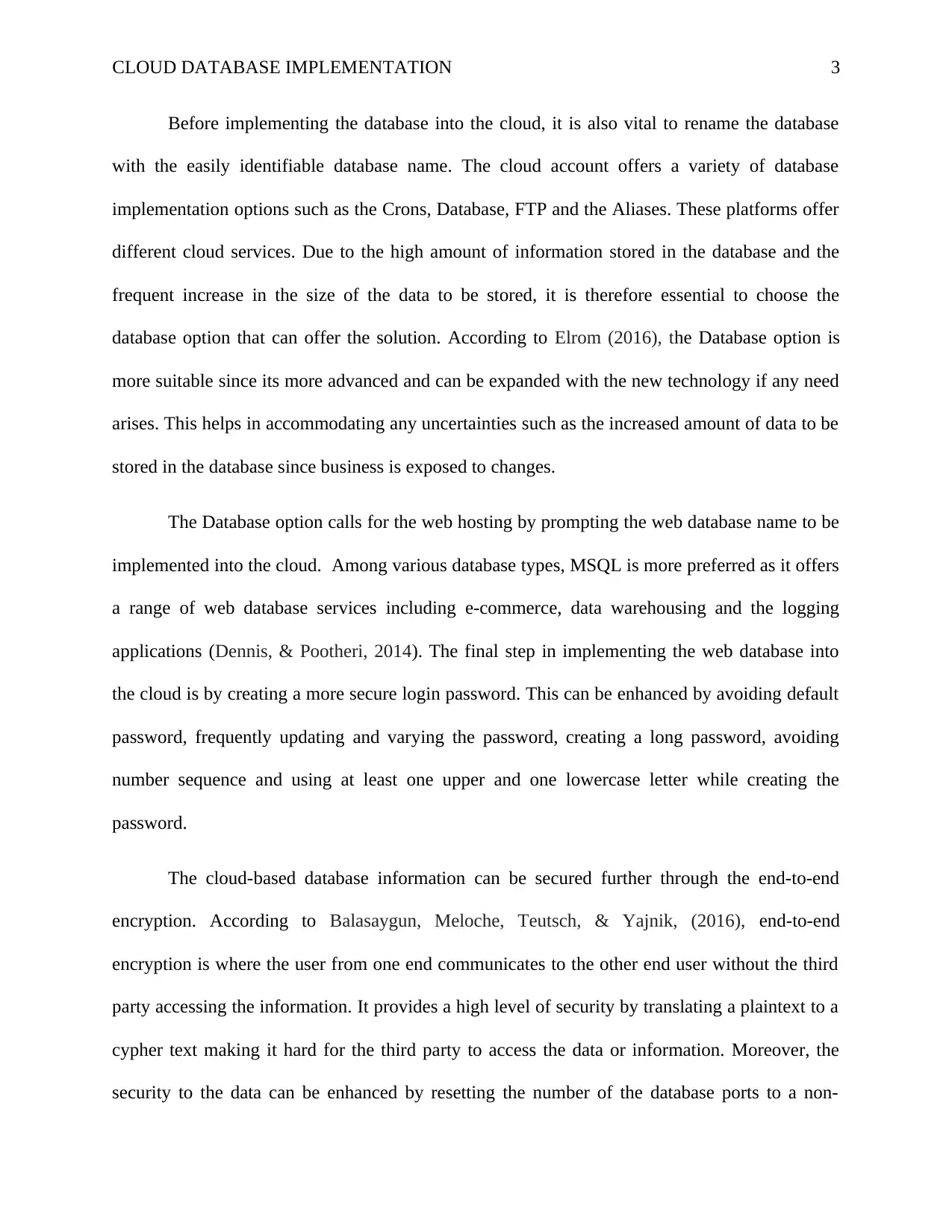
CLOUD DATABASE IMPLEMENTATION 3
Before implementing the database into the cloud, it is also vital to rename the database
with the easily identifiable database name. The cloud account offers a variety of database
implementation options such as the Crons, Database, FTP and the Aliases. These platforms offer
different cloud services. Due to the high amount of information stored in the database and the
frequent increase in the size of the data to be stored, it is therefore essential to choose the
database option that can offer the solution. According to Elrom (2016), the Database option is
more suitable since its more advanced and can be expanded with the new technology if any need
arises. This helps in accommodating any uncertainties such as the increased amount of data to be
stored in the database since business is exposed to changes.
The Database option calls for the web hosting by prompting the web database name to be
implemented into the cloud. Among various database types, MSQL is more preferred as it offers
a range of web database services including e-commerce, data warehousing and the logging
applications (Dennis, & Pootheri, 2014). The final step in implementing the web database into
the cloud is by creating a more secure login password. This can be enhanced by avoiding default
password, frequently updating and varying the password, creating a long password, avoiding
number sequence and using at least one upper and one lowercase letter while creating the
password.
The cloud-based database information can be secured further through the end-to-end
encryption. According to Balasaygun, Meloche, Teutsch, & Yajnik, (2016), end-to-end
encryption is where the user from one end communicates to the other end user without the third
party accessing the information. It provides a high level of security by translating a plaintext to a
cypher text making it hard for the third party to access the data or information. Moreover, the
security to the data can be enhanced by resetting the number of the database ports to a non-
Before implementing the database into the cloud, it is also vital to rename the database
with the easily identifiable database name. The cloud account offers a variety of database
implementation options such as the Crons, Database, FTP and the Aliases. These platforms offer
different cloud services. Due to the high amount of information stored in the database and the
frequent increase in the size of the data to be stored, it is therefore essential to choose the
database option that can offer the solution. According to Elrom (2016), the Database option is
more suitable since its more advanced and can be expanded with the new technology if any need
arises. This helps in accommodating any uncertainties such as the increased amount of data to be
stored in the database since business is exposed to changes.
The Database option calls for the web hosting by prompting the web database name to be
implemented into the cloud. Among various database types, MSQL is more preferred as it offers
a range of web database services including e-commerce, data warehousing and the logging
applications (Dennis, & Pootheri, 2014). The final step in implementing the web database into
the cloud is by creating a more secure login password. This can be enhanced by avoiding default
password, frequently updating and varying the password, creating a long password, avoiding
number sequence and using at least one upper and one lowercase letter while creating the
password.
The cloud-based database information can be secured further through the end-to-end
encryption. According to Balasaygun, Meloche, Teutsch, & Yajnik, (2016), end-to-end
encryption is where the user from one end communicates to the other end user without the third
party accessing the information. It provides a high level of security by translating a plaintext to a
cypher text making it hard for the third party to access the data or information. Moreover, the
security to the data can be enhanced by resetting the number of the database ports to a non-
⊘ This is a preview!⊘
Do you want full access?
Subscribe today to unlock all pages.

Trusted by 1+ million students worldwide
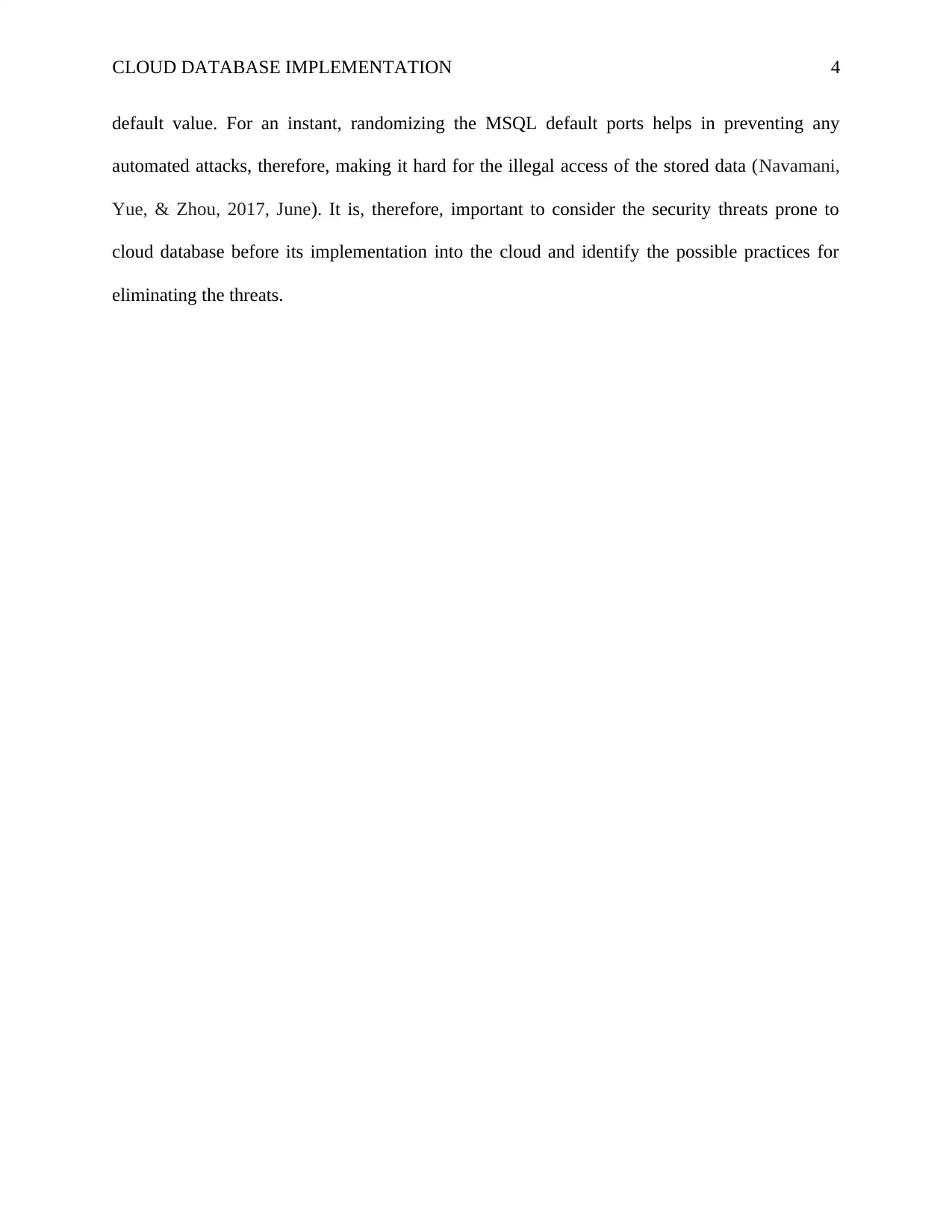
CLOUD DATABASE IMPLEMENTATION 4
default value. For an instant, randomizing the MSQL default ports helps in preventing any
automated attacks, therefore, making it hard for the illegal access of the stored data (Navamani,
Yue, & Zhou, 2017, June). It is, therefore, important to consider the security threats prone to
cloud database before its implementation into the cloud and identify the possible practices for
eliminating the threats.
default value. For an instant, randomizing the MSQL default ports helps in preventing any
automated attacks, therefore, making it hard for the illegal access of the stored data (Navamani,
Yue, & Zhou, 2017, June). It is, therefore, important to consider the security threats prone to
cloud database before its implementation into the cloud and identify the possible practices for
eliminating the threats.
Paraphrase This Document
Need a fresh take? Get an instant paraphrase of this document with our AI Paraphraser
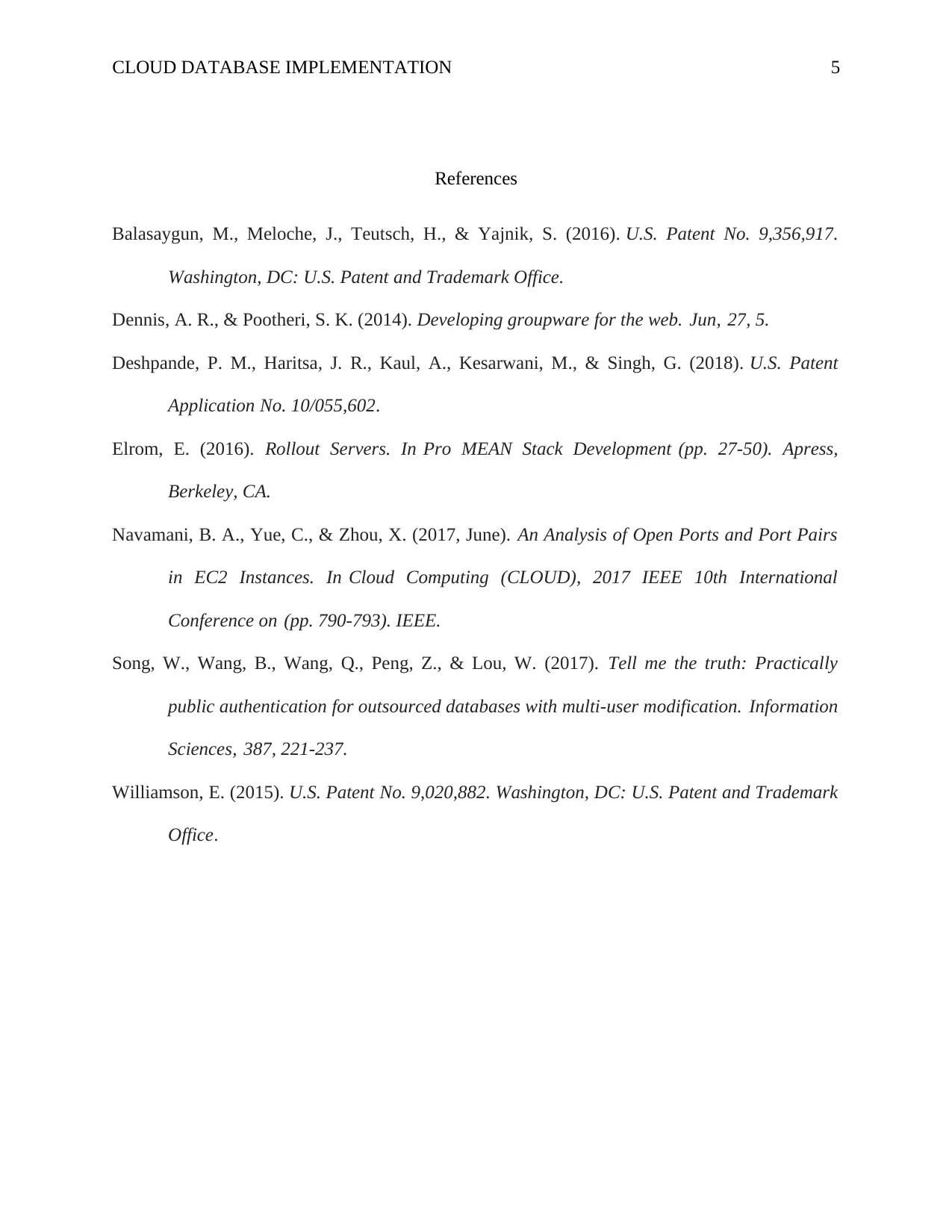
CLOUD DATABASE IMPLEMENTATION 5
References
Balasaygun, M., Meloche, J., Teutsch, H., & Yajnik, S. (2016). U.S. Patent No. 9,356,917.
Washington, DC: U.S. Patent and Trademark Office.
Dennis, A. R., & Pootheri, S. K. (2014). Developing groupware for the web. Jun, 27, 5.
Deshpande, P. M., Haritsa, J. R., Kaul, A., Kesarwani, M., & Singh, G. (2018). U.S. Patent
Application No. 10/055,602.
Elrom, E. (2016). Rollout Servers. In Pro MEAN Stack Development (pp. 27-50). Apress,
Berkeley, CA.
Navamani, B. A., Yue, C., & Zhou, X. (2017, June). An Analysis of Open Ports and Port Pairs
in EC2 Instances. In Cloud Computing (CLOUD), 2017 IEEE 10th International
Conference on (pp. 790-793). IEEE.
Song, W., Wang, B., Wang, Q., Peng, Z., & Lou, W. (2017). Tell me the truth: Practically
public authentication for outsourced databases with multi-user modification. Information
Sciences, 387, 221-237.
Williamson, E. (2015). U.S. Patent No. 9,020,882. Washington, DC: U.S. Patent and Trademark
Office.
References
Balasaygun, M., Meloche, J., Teutsch, H., & Yajnik, S. (2016). U.S. Patent No. 9,356,917.
Washington, DC: U.S. Patent and Trademark Office.
Dennis, A. R., & Pootheri, S. K. (2014). Developing groupware for the web. Jun, 27, 5.
Deshpande, P. M., Haritsa, J. R., Kaul, A., Kesarwani, M., & Singh, G. (2018). U.S. Patent
Application No. 10/055,602.
Elrom, E. (2016). Rollout Servers. In Pro MEAN Stack Development (pp. 27-50). Apress,
Berkeley, CA.
Navamani, B. A., Yue, C., & Zhou, X. (2017, June). An Analysis of Open Ports and Port Pairs
in EC2 Instances. In Cloud Computing (CLOUD), 2017 IEEE 10th International
Conference on (pp. 790-793). IEEE.
Song, W., Wang, B., Wang, Q., Peng, Z., & Lou, W. (2017). Tell me the truth: Practically
public authentication for outsourced databases with multi-user modification. Information
Sciences, 387, 221-237.
Williamson, E. (2015). U.S. Patent No. 9,020,882. Washington, DC: U.S. Patent and Trademark
Office.
1 out of 5
Related Documents
Your All-in-One AI-Powered Toolkit for Academic Success.
+13062052269
info@desklib.com
Available 24*7 on WhatsApp / Email
![[object Object]](/_next/static/media/star-bottom.7253800d.svg)
Unlock your academic potential
Copyright © 2020–2025 A2Z Services. All Rights Reserved. Developed and managed by ZUCOL.





